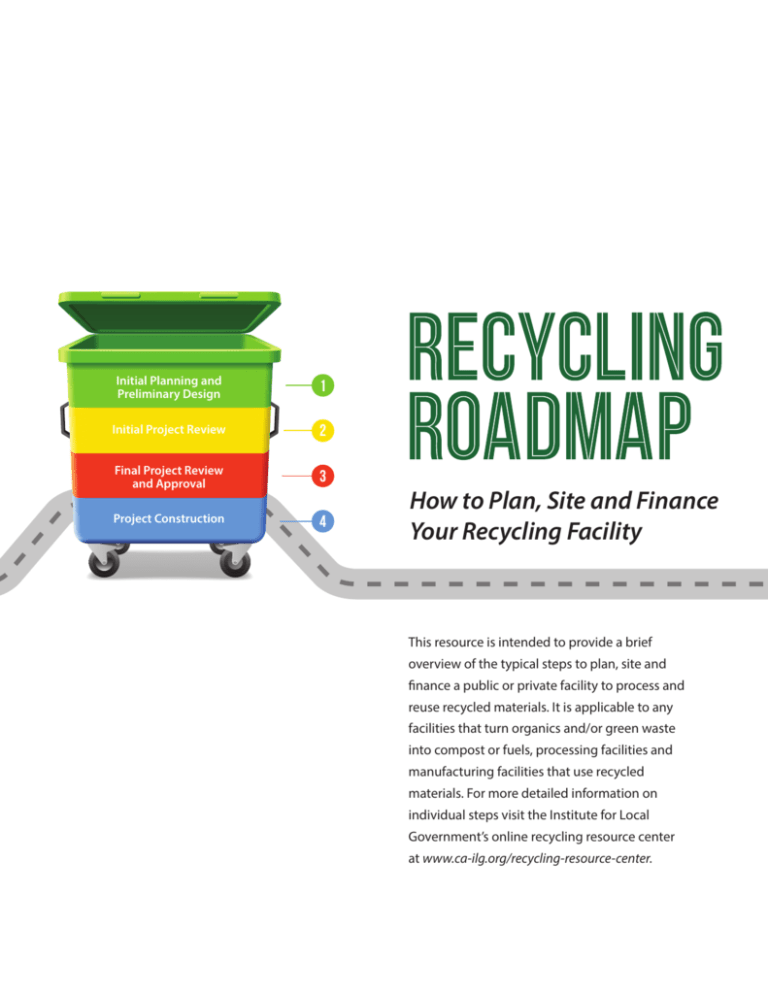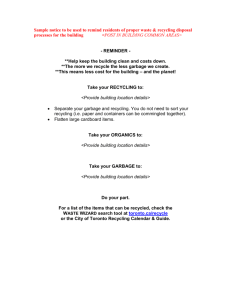
Initial Planning and
Preliminary Design
1
Initial Project Review
2
Final Project Review
and Approval
3
Project Construction
4
How to Plan, Site and Finance
Your Recycling Facility
This resource is intended to provide a brief
overview of the typical steps to plan, site and
finance a public or private facility to process and
reuse recycled materials. It is applicable to any
facilities that turn organics and/or green waste
into compost or fuels, processing facilities and
manufacturing facilities that use recycled
materials. For more detailed information on
individual steps visit the Institute for Local
Government’s online recycling resource center
at www.ca-ilg.org/recycling-resource-center.
Planning &
Siting
Process
Identify the Potential
Site/Facility Location
Begin Public
Engagement/
Outreach Process
Research land use planning and
zoning provisions related to identified
sites. Contact local agency planning
departments while still “shopping” for
a site and review local general plan
and local zoning ordinances.
Reach out to residents living
nearby the proposed facility and
other interested stakeholder
groups to inform them of the
potential project and solicit their
input / feedback as appropriate.
1
Continue Public
Outreach
9
Public Hearings (when
applicable) / Approval
of Land Use Permit
7
Projects often require review and approval by
the city or county planning departments as
well as other government agencies. The review
time varies by agency, for some agencies it’s 30
days, 60 days or 90 days from submission.
Obtain Building
Permits and Other
Preconstruction
Permits / Approvals
Construction
and Inspections
• Solid Waste Facility Permit
(typically from Local Enforcement Agency)
• Excluded Solid Waste Handling
• Enforcement Agency Notification
• Registration Permit
• Standardized Permit
• Full Permit
Project examples include:
• Turn organics / green waste
into compost or fuels.
• Process and/or use recycled
materials in manufacturing
4
3
Identify Which
Permits or Licenses
will be Necessary
The type of local agency permit or license
is likely to be the same (i.e. conditional use
permit) but the details will vary greatly
depending on the specific characteristics
of each type of activity (i.e. manufacturing
vs organic composting).
6
Review by Agency Staff
10
Consult regulations for the city and
county where the project will be located
as part of project design. Keep in mind
that the source and amount of funding
can and will affect project design.
Prepare and Submit
Applications
Common issues of concern can include:
agricultural, air quality, archaeological,
biological, noise, odor and traffic impacts.
8
Start Project Design
2
Application Review
and Preparation of
Environmental Document
5
Preliminary Meetings
with Public Agencies
Local Health and Safety Permits
(for hazardous materials) from a local Certified Unified
Program Agency and/or the California Department of
Toxic Substances Control
• Air Permits
from local air quality management district(s) and
emission offsets (if available) in non-attainment areas
• Water Quality Permits
from regional water board(s) such as National Pollutant
Discharge Elimination System permits or individual waste
discharge requirements.
Department of Food and Agriculture Permits
Department of Industrial Relations Permits
(for air compressors)
Occupational Safety and Health
Administration Permits
Continue Public
Outreach
The specific agencies involved vary by
jurisdiction, but may include the
agencies listed on the right.
Opening Day!
11
• Local Land Use and Design Permits and Licenses
(to comply with local zoning and land use laws)
• General Plan Amendment
• Zoning Variance
• Conditional Use Permit
• Coastal Permit
• Countywide Siting Element
• Non-Disposal Facility Element
Local Agencies
City and County Departments of Building and Safety,
Planning, Public Works, Solid Waste, Water, Fire
Department, Local Enforcement Agency and others
Regional Agencies
Waste Management Joint Powers Authority (consisting
of multiple local agencies) Air Pollution Control District,
Air Quality Management District, Regional Water
Quality Control Board
State Agencies
CalRecycle, California Department of Food and
Agriculture, California Department of Industrial
Relations
Federal Agencies
U.S. Environmental Protection Agency
Financing Process
Investigate Funding Sources - consider one or more of
the following methods to fund a public or private
recycling facility. Keep in mind that the source and
amount of funding can and will affect project design.
• Bonds
• Public agency funds
• Public-private joint funding
• State agency grants and loans
Determine How the Recycling Program or Facility will be
Funded - common approaches include one or a
combination of the following funding mechanisms:
• User fees / rates on the collection of trash,
recyclables and organics/green waste,
• Franchise fees on solid waste and recycling
service providers,
• Solid waste or non-disposal facility gate
(tipping fees for green waste/food waste fees
at a composting or anaerobic digestion facility),
• Local agency “host” fees on recycling or disposal
facilities,
• Sale of recyclable and recycled content materials,
• Agency’s general fund, or
• Other mechanisms, such as locally imposed taxes.
Where to find more information
ILG Recycling Resource Center
www.ca-ilg.org/recycling-resource-center
The ILG Recycling Resource Center includes documents,
webinars and case examples to help local governments
finance and site recycling projects and programs in their
communities. The commercial recycling section includes
resources to help local officials increase commercial recycling
in their communities.
Key resources include:
• Connecting the Dots: Recycling, Climate and Economic
Development offers an explanation of the connections
between recycling, climate and economic development.
• Financing Recycling Programs and Facilities:
Understanding Options and Resources offers an
overview of the current methods that local agencies use
to fund their recycling programs and how the public and
private sectors are financing recycling facilities.
• A Primer on Recycling Facilities offers a basic description
of recycling collection and processing systems, types of
recycling facilities and the potential benefits to the
communities where they are located.
Acknowledgements
The Institute gratefully acknowledges the following individuals
who reviewed this document and offered their comments prior
to publication:
• Christopher Bria, Senior Environmental Scientist, CalRecycle
• John Davis, Administrator, Mojave Desert and
Mountain Recycling
• Dr. Howard Levenson, Deputy Director, CalRecycle
• Rick Marshall, Deputy Director of Public Works, Napa County
Public Works
• Chris Stephens, Director, Resource Management Agency,
County of Ventura
• Lisa Wood, Planner, City of San Diego
Prepared by:
Steve Sanders and Christal Love Lazard, ILG Staff
Tina Chen, Graphic Designer
© 2015 Institute for Local Government. All rights reserved.
The material included in this short guide is for informational
purposes only and should not be viewed as legal or financial
advice. Local agencies and others should consult with their
attorneys about their individual agencies’ circumstances.
Prepared as part of CalRecycle contract number DRR12063,
Total Contract Amount $200,000, pursuant to Government Code
Section 7550.








![School [recycling, compost, or waste reduction] case study](http://s3.studylib.net/store/data/005898792_1-08f8f34cac7a57869e865e0c3646f10a-300x300.png)